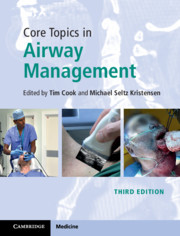Book contents
- Core Topics in Airway Management
- Core Topics in Airway Management
- Copyright page
- Contents
- Contributors
- Foreword
- Preface to the Third Edition
- Section 1 Airway Management: Background and Techniques
- Chapter 1 Anatomy
- Chapter 2 Physiology of Apnoea, Hypoxia and Airway Reflexes
- Chapter 3 The Epidemiology of Airway Management Complications
- Chapter 4 Structured Planning of Airway Management
- Chapter 5 Pre-anaesthetic Airway Assessment
- Chapter 6 Pre-anaesthetic Airway Endoscopy, Real and Virtual
- Chapter 7 Ultrasonography for Airway Management
- Chapter 8 Oxygenation: before, during and after Airway Management
- Chapter 9 Awake Tracheal Intubation
- Chapter 10 Drugs for Airway Management
- Chapter 11 How to Avoid Morbidity from Aspiration of Gastric Content to the Lungs
- Chapter 12 Face Mask Ventilation
- Chapter 13 Supraglottic Airways
- Chapter 14 Tracheal Intubation: Direct Laryngoscopy
- Chapter 15 Tracheal Tube Introducers (Bougies), Stylets and Airway Exchange Catheters
- Chapter 16 Tracheal Intubation Using the Flexible Optical Bronchoscope
- Chapter 17 Videolaryngoscopy
- Chapter 18 Expiratory Ventilation Assistance and Ventilation through Narrow Tubes
- Chapter 19 Multimodal Techniques for Airway Management
- Chapter 20 Front of Neck Airway (FONA)
- Chapter 21 Extubation
- Section 2 Airway Management: Clinical Settings and Subspecialties
- Section 3 Airway Management: Organisation
- Index
- References
Chapter 10 - Drugs for Airway Management
from Section 1 - Airway Management: Background and Techniques
Published online by Cambridge University Press: 03 October 2020
- Core Topics in Airway Management
- Core Topics in Airway Management
- Copyright page
- Contents
- Contributors
- Foreword
- Preface to the Third Edition
- Section 1 Airway Management: Background and Techniques
- Chapter 1 Anatomy
- Chapter 2 Physiology of Apnoea, Hypoxia and Airway Reflexes
- Chapter 3 The Epidemiology of Airway Management Complications
- Chapter 4 Structured Planning of Airway Management
- Chapter 5 Pre-anaesthetic Airway Assessment
- Chapter 6 Pre-anaesthetic Airway Endoscopy, Real and Virtual
- Chapter 7 Ultrasonography for Airway Management
- Chapter 8 Oxygenation: before, during and after Airway Management
- Chapter 9 Awake Tracheal Intubation
- Chapter 10 Drugs for Airway Management
- Chapter 11 How to Avoid Morbidity from Aspiration of Gastric Content to the Lungs
- Chapter 12 Face Mask Ventilation
- Chapter 13 Supraglottic Airways
- Chapter 14 Tracheal Intubation: Direct Laryngoscopy
- Chapter 15 Tracheal Tube Introducers (Bougies), Stylets and Airway Exchange Catheters
- Chapter 16 Tracheal Intubation Using the Flexible Optical Bronchoscope
- Chapter 17 Videolaryngoscopy
- Chapter 18 Expiratory Ventilation Assistance and Ventilation through Narrow Tubes
- Chapter 19 Multimodal Techniques for Airway Management
- Chapter 20 Front of Neck Airway (FONA)
- Chapter 21 Extubation
- Section 2 Airway Management: Clinical Settings and Subspecialties
- Section 3 Airway Management: Organisation
- Index
- References
Summary
Correct choice and use of drugs is fundamental to airway management success and safety. This is true for both elective and emergency anaesthesia and at the start and end of anaesthesia. This chapter describes the key elements of drug selection for safe, effective airway management in both the awake and anaesthetised patient. Drugs can importantly facilitate airway management and influence conditions for tracheal intubation or inserting a supraglottic airway. Depression of reflexes and muscle tone can be provided by several hypnotics, but propofol is usually most effective. Neuromuscular blocking agents are not needed for many forms of airway management but can optimise conditions when necessary. The anaesthetist must be familiar with dosing and timing and with quantitative monitoring during reversal. Local anaesthesia may be the only safe choice in managing the difficult airway and sedation can enhance patient tolerance but maintaining adequate spontaneous ventilation is sometimes a challenge.
Keywords
- Type
- Chapter
- Information
- Core Topics in Airway Management , pp. 87 - 90Publisher: Cambridge University PressPrint publication year: 2020



